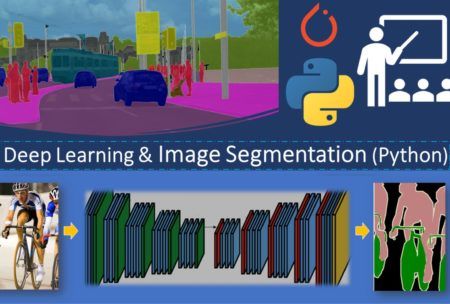Learn Semantic Segmentation Complete Pipeline and its Real-world Applications with Python and PyTorch using Google Colab.
Read more.Instructor
Mazhar Hussain is currently in the role of Deep Learning and Computer Vision Engineer. He has extensive teaching experience at University Higher Education level and Online over a decade. He has published several research papers on Deep Learning in well-reputed Journals and Conferences. He believes on comprehensive practical trainings with stunning support for his students where all his courses are 100% hands-on with step-by-step problem-based learning, demos and examples. Mazhar Hussain is te
Access all courses in our library for only $9/month with All Access Pass
Get Started with All Access PassBuy Only This CourseAbout This Course
Who this course is for:
- Machine Learning Engineers, Deep Learning Engineers, and Data Scientists who want to apply Deep Learning to Image Segmentation tasks
- Computer Vision Engineers and Researchers who want to learn how to use PyTorch to build and train Deep Learning models for Semantic Segmentation
- Developers who want to incorporate Semantic Segmentation capabilities into their projects
- Graduates and Researchers in Computer Science, Electrical Engineering, and other related fields who want to learn about the latest advances in Deep Learning for Semantic Segmentation
- In general, the course is for anyone who wants to learn how to use Deep Learning to extract meaning from visual data and gain a deeper understanding of the theory and practical applications of Semantic Segmentation using Python and PyTorch
What you’ll learn:
- Learn Semantic Segmentation Complete Pipeline and its Real-world Applications with Python and PyTorch using Google Colab
- Deep Learning Architectures for Semantic Segmentation (UNet, DeepLabV3, PSPNet, PAN, UNet++, MTCNet etc.)
- Datasets and Data annotations Tool for Semantic Segmentation
- Data Augmentation and Data Loaders Implementation in PyTorch
- Learn Performance Metrics (IOU, etc.) for Segmentation Models Evaluation
- Transfer Learning and Pretrained Deep Resnet Architecture
- Segmentation Models (UNet, PSPNet, DeepLab, PAN, UNet++) Implementation in PyTorch using different Encoder and Decoder Architectures
- Learn to Optimize Hyperparameters for Segmentation Models to Improve the Performance during Training
- Test Segmentation Trained Model and Calculate IOU, Class-wise IOU, Pixel Accuracy, Precision, Recall and F-score
- Visualize Segmentation Results and Generate RGB Predicted Output Segmentation Map
Requirements:
- Deep Learning for Semantic Segmentation with Python and PyTorch is taught in this course by following a complete pipeline from Zero to Hero
- No prior knowledge of Semantic Segmentation is assumed. Everything will be covered with hands-on training.
- A Google Gmail account is required to get started with Google Colab to write Python Code
This course is designed to provide a comprehensive, hands-on experience in applying Deep Learning techniques to Semantic Segmentation problems.
Are you ready to take your understanding of deep learning to the next level and learn how to apply it to real-world problems? In this course, you’ll learn how to use the power of Deep Learning to segment images and extract meaning from visual data. You’ll start with an introduction to the basics of Semantic Segmentation using Deep Learning, then move on to implementing and training your own models for Semantic Segmentation with Python and PyTorch.This course is designed for a wide range of students and professionals.
By the end of this course, you’ll have the knowledge and skills you need to start applying Deep Learning to Semantic Segmentation problems in your own work or research. Whether you’re a Computer Vision Engineer, Data Scientist, or Developer, this course is the perfect way to take your understanding of Deep Learning to the next level. Let’s get started on this exciting journey of Deep Learning for Semantic Segmentation with Python and PyTorch.
Our Promise to You
By the end of this course, you will have learned Semantic Segmentation.
10 Day Money Back Guarantee. If you are unsatisfied for any reason, simply contact us and we’ll give you a full refund. No questions asked.
Get started today!
Course Curriculum
| Section 1 - Introduction To Course | |||
| Introduction | 00:00:00 | ||
| Downloadable Codes | 00:00:00 | ||
| Section 2 - Semantic Segmentation And Its Real-World Applications | |||
| What Is Semantic Image Segmentation? | 00:00:00 | ||
| Semantic Segmentation Real-World Applications | 00:00:00 | ||
| Section 3 - Deep Learning Architectures For Segmentation (UNet, PSPNet, PAN, MTCNet) | |||
| Pyramid Scene Parsing Network (PSPnet) For Segmentation | 00:00:00 | ||
| UNet Architecture For Segmentation | 00:00:00 | ||
| Pyramid Attention Network (PAN) For Segmentation | 00:00:00 | ||
| Multi-Task Contextual Network (MTCNet) For Segmentation | 00:00:00 | ||
| Section 4 - Datasets And Data Annotations Tool For Semantic Segmentation | |||
| Explore Datasets For Semantic Segmentation | 00:00:00 | ||
| Data Annotations Tool For Semantic Segmentation | 00:00:00 | ||
| Section 5 - Google Colab Setting-Up For Writing Python Code | |||
| Set-Up Google Colab For Writing Segmentation With Python And PyTorch Code | 00:00:00 | ||
| Connect Google Colab With Google Drive To Read And Write Data | 00:00:00 | ||
| Section 6 - Data Augmentation And Data Loading | |||
| Data Loading With PyTorch Customized Dataset Class | 00:00:00 | ||
| Perform Data Augmentation Using Albumentations With Different Transformations | 00:00:00 | ||
| Learn To Implement Data Loaders With PyTorch | 00:00:00 | ||
| Section 7 - Performance Metrics (IOU) For Segmentation Models Evaluation | |||
| Performance Metrics (IOU, Pixel Accuracy) For Segmentation Models Evaluation | 00:00:00 | ||
| Section 8 - Transfer Learning And Pretrained Deep Resnet Architecture | |||
| Learn Transfer Learning And Pretrained Deep Resnet Architecture | 00:00:00 | ||
| Section 9 - Encoders And Decoders For Segmentation In PyTorch | |||
| Pretrained Encoders For Semantic Image Segmentation With PyTorch | 00:00:00 | ||
| Decoders For Semantic Segmentation Using PyTorch | 00:00:00 | ||
| Section 10 - Implement Segmentation Models (UNet, PSPNet, DeepLab, PAN, UNet++) Using PyTorch | |||
| UNet, PSPNet, DeepLab, PAN, UNet++, Segmentation Models With PyTorch And Python | 00:00:00 | ||
| Section 11 - Optimization And Training Of Segmentation Models | |||
| Learn To Optimize Hyperparameters For Semantic Segmentation Models | 00:00:00 | ||
| Semantic Image Segmentation Models With PyTorch Training | 00:00:00 | ||
| Section 12 - Test Models And Visualize Segmentation Results | |||
| Run And Test Segmentation Models And Calculate Class-Wise IOU, Accuracy, Fscore | 00:00:00 | ||
| Visualize Segmentation Results And Generate RGB Predicted Segmentation Map | 00:00:00 | ||
| Section 13 - Bonus Lecture Resources - Code And Dataset Of Semantic Segmentation | |||
| Please Find Attached Complete Code And Dataset Of Segmentation With Deep Learning | 00:00:00 | ||
| Final Code | 00:00:00 | ||
| Tray Dataset For Segmentation | 00:00:00 | ||



